Potřebujeme váš souhlas k využití jednotlivých dat, aby se vám mimo jiné mohly ukazovat informace týkající se vašich zájmů. Souhlas udělíte kliknutím na tlačítko „OK“.
ASTM E1124-10
Standard Test Method for Field Measurement of Sound Power Level by the Two-Surface Method
Automaticky přeložený název:
Standardní zkušební metoda pro zorné pole pro měření hladiny akustického výkonu podle metodou Dva-Surface
NORMA vydána dne 1.5.2010
Informace o normě:
Označení normy: ASTM E1124-10
Poznámka: NEPLATNÁ
Datum vydání normy: 1.5.2010
Kód zboží: NS-40546
Počet stran: 7
Přibližná hmotnost: 21 g (0.05 liber)
Země: Americká technická norma
Kategorie: Technické normy ASTM
Kategorie - podobné normy:
Anotace textu normy ASTM E1124-10 :
Keywords:
field sound power, industrial noise, machinery noise, sound power, two-surface method, Acoustical tests, Ambient sound pressure levels, Band filter sets, Concave measurement surfaces, Conformal measurement surfaces, Convex measurement surfaces, Field testing--sound transmission, Leveling characteristics, Microphones, Noise level measurement, One-third octave band sound pressure levels, Relative assessment, Sound transmission--building materials/applications
Doplňující informace
| Significance and Use | ||||
|
The function and operation of equipment in the field often preclude the measurement of the free-field sound pressure levels of a single piece of equipment in the absence of interfering sound from other equipment operating at the same time. The two-surface method will provide, in most cases, a reliable estimate of the normal sound power levels of a specimen operating in an adverse environment. This test method is intended for use in the field in the presence of what is normally regarded as interfering background noise. This test method is based upon the work of Hubner , and Diehl, but differs from all other current sound power measurement procedures by requiring simultaneous measurement at both conformal surfaces and by resolving time-averaged sound pressure levels at both surfaces to within 0.1 dB. These two features, simultaneous recording and 0.1dB resolution, enable source sound power to be calculated when the direct sound field of the source is actually lower in level than the ambient noise. The use of this test method is expected to be primarily for the relative assessment of the sound power from similar sources or for the prediction of sound levels in a plant based upon measurements of similar sources in another plant. This test method is believed to be capable of yielding a reasonably good estimate of absolute power level with proper care of application and full conformance to the provisions of this procedure. The two-surface method is applicable only when the two measurement surfaces can be physically selected to produce positive values of the difference in average sound pressure level. That is, the inner surface sound pressure level minus the outer surface sound pressure level must be at least +0.1 dB. This limitation applies to each frequency band and each constituent surface area investigated. Only the frequency band in which a zero or negative difference occurs is it considered invalid and usually adjacent bands will be valid. In practice, only rarely will all three one-third octave bands of a given octave yield invalid data at all constituent areas. Therefore, less than complete results are permissible when one-third octave analysis is used and full octave results are reported. The two-surface method may not produce results when testing some very large machines in very reverberant rooms or in rooms having a volume less than about 20 times the space enclosed by an envelope around the larger dimensions of the machine. In such cases, the sound pressure level close to the machine may not decrease in any regular way with increasing distance from a machine surface, making it impossible to select two measurement surfaces producing positive differences of sound pressure level. |
||||
| 1. Scope | ||||
|
1.1 This test method covers the field, or in situ measurement of sound power level by the two-surface method. The test method is designed to minimize the effects of reverberant conditions, directivity of the noise source under consideration, and the effects of ambient noise from other nearby equipment operating at the same time. 1.2 This standard does not purport to address all of the safety concerns, if any, associated with its use. It is the responsibility of the user of this standard to establish appropriate safety and health practices and determine the applicability of regulatory limitations prior to use. |
||||
| 2. Referenced Documents | ||||
|
Podobné normy:
Historická
1.8.2013
Historická
15.6.2012
Historická
1.2.2013
Historická
15.1.2008
Historická
1.3.2014
Historická
1.9.2010


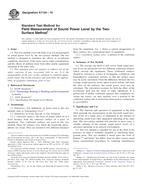
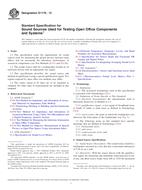 ASTM E1179-13
ASTM E1179-13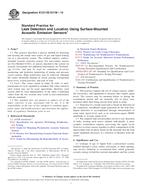 ASTM E1211/E1211M-12..
ASTM E1211/E1211M-12..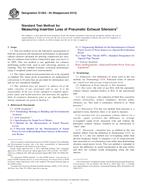 ASTM E1265-04(2013)..
ASTM E1265-04(2013)..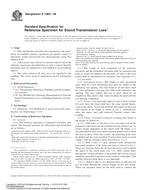 ASTM E1289-08
ASTM E1289-08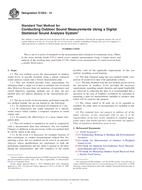 ASTM E1503-14
ASTM E1503-14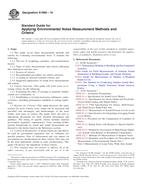 ASTM E1686-10
ASTM E1686-10
 Cookies
Cookies
